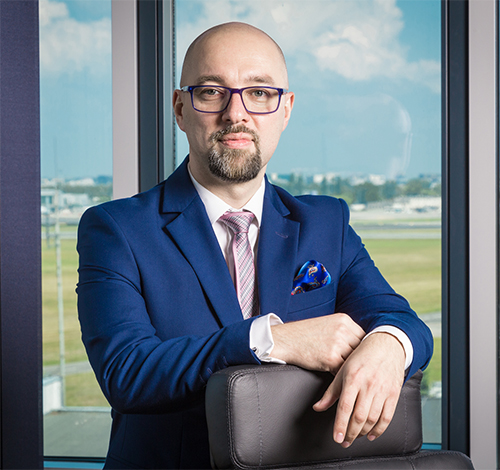PANSA, the Polish air navigation service provider, is an active member of the SESAR Joint Undertaking through the B4 Consortium. Over the past 4 years, PANSA has contributed significantly to all aspects of the programme, from setting the vision to the future, to researching and delivering new innovative solutions.

Janusz Janiszewski, President of the Polish Air Navigation Services Agency shares his view on the importance of working collaboratively on innovation:
“At Polish Air Navigation Services Agency we fully understand the importance of innovative solutions in the modern aviation market. The time of pandemic has especially shown how flexible and adjustable we have to be and that nothing is permanent – no matter how confident we are about it.
Progress that we all need, can only be achieved with proper research and innovation programmes, such as SESAR 2020. At PANSA, we continue our efforts to develop own technologies supporting ATC and improving airspace management, as outlined in the European ATM Master Plan. Our new solutions are eco-friendly. We design them to provide our ops personnel with as much data as possible and significantly reduce their workload. Each day, our controllers benefit from, among others, SESAR-related innovations that are designed to support them.
We know that the future is happening already. We have implemented and launched PansaUTM – a system in ATCOs’ operational use, inspired by the U-space concept of operations aimed at safely integrating drones with manned aircraft traffic. We currently use or evolve towards popularising augmented reality, virtual and remote solutions, more accurate navigation and other technologies that just a few decades ago were considered abstract concepts.
It is important for all of us to realise it. Especially now, when the global air traffic control celebrates its centenary and the next one hundred years may be even more unpredictable. All aviation stakeholders should understand the need to focus on innovations, which seem to be crucial for further development. It shall be our common goal and we all must continue to act in the research and innovation area.”
Here is an overview of the solutions/project to which PANSA is actively contributing.
Airports
-
Improved access to secondary airports, which aims to develop and validate advanced operational and technical solutions enabling an increase in the availability of small/medium airports in all weather conditions, including limited visibility;
-
Safety support tools for avoiding runway excursions, which aims to develop and validate advanced operational and technical solutions that reduce the risk of runway excursions in all airport operational areas;
-
Total Airport Management: Network connected airports, which aims to develop and validate advanced operational and technical solutions supporting the integration of airports and the Network;
-
Total Airport Management: Digital smart airports, which aims to develop and validate advanced operational and technical solutions supporting airport stakeholders in collaborative decision-making improving airport performance;
-
Multiple remote tower and remote tower centre, which aims to validate advanced operational and technical solutions that increase the availability of remote air traffic services through the use of RTC (Remote Tower Center);
-
Surface traffic alerts improve runway safety, which aims to demonstrate the technological readiness of solutions improving safety on the runway to the industrialisation phase;
Air traffic services
-
Delegation of airspace between ATSUs using virtual centre concept, which aims to validate the concept of “Delegation of airspace between ATSUs” in real conditions arising from the needs of emergency situations and operational and organizational needs, taking into account the impact on services defined in the concept of “Virtual Center”;
-
IFR RPAS integration in airspace class A to C, which aims to develop and validate operational and technical solutions ensuring the possibility of performing operations of unmanned aerial vehicles alongside IFR traffic in the controlled space A to C;
-
4D Skyways: Improved ground trajectory predictions enabling future automation tools, which aims to develop tools for ATCOs using technical solutions to improve trajectory prediction (Wave 1 result) to improve the quality of separation management in the En-route and TMA environment;
-
4D Skyways: Improved vertical profiles through safe vertical clearances, which aims to develop and verify operational procedures for ATC and crews in trajectory-based operations) conditions using complex ATC permits for immediate flight profile changes or anticipated changes in flight trajectories with the support of tools increasing the level of ATC/cockpit automation;
-
4D Skyways: Trajectory prediction common service, which aims to develop a architecture for providing services to ATM process participants with reliable information about the anticipated flight trajectory ensuring cost-effective transition to TBO based operations management;
-
Optimised Airspace Uses Operations: Mission trajectories management with integrated Dynamic Mobile Areas Type 1 and Type 2, which aims to further validate the concept of Dynamic Airspace Configuration (DAC) based on the management of mission trajectories (MT) integrated with the management of new type zones, i.e. Dynamic Mobile Area (DMA) integrated with related cooperation processes between entities participating in ASM processes;
Network operations
Digital network management services: Dynamic Airspace Configurations (DAC), which aims to develop and validate a solution that improves the use of airspace capacity for both civilian and military users by increasing the level of detail and flexibility in airspace configuration;
Transversal
-
Content integration project, covering activities supporting the implementation of the SESAR 2020 Program aimed at ensuring the delivery of SESAR operational and technological solutions in accordance with the ATM Master Plan;
-
Master planning project, covering activities aimed at ensuring strategic control of SESAR 2020 projects in line with SESAR Vision priorities.

